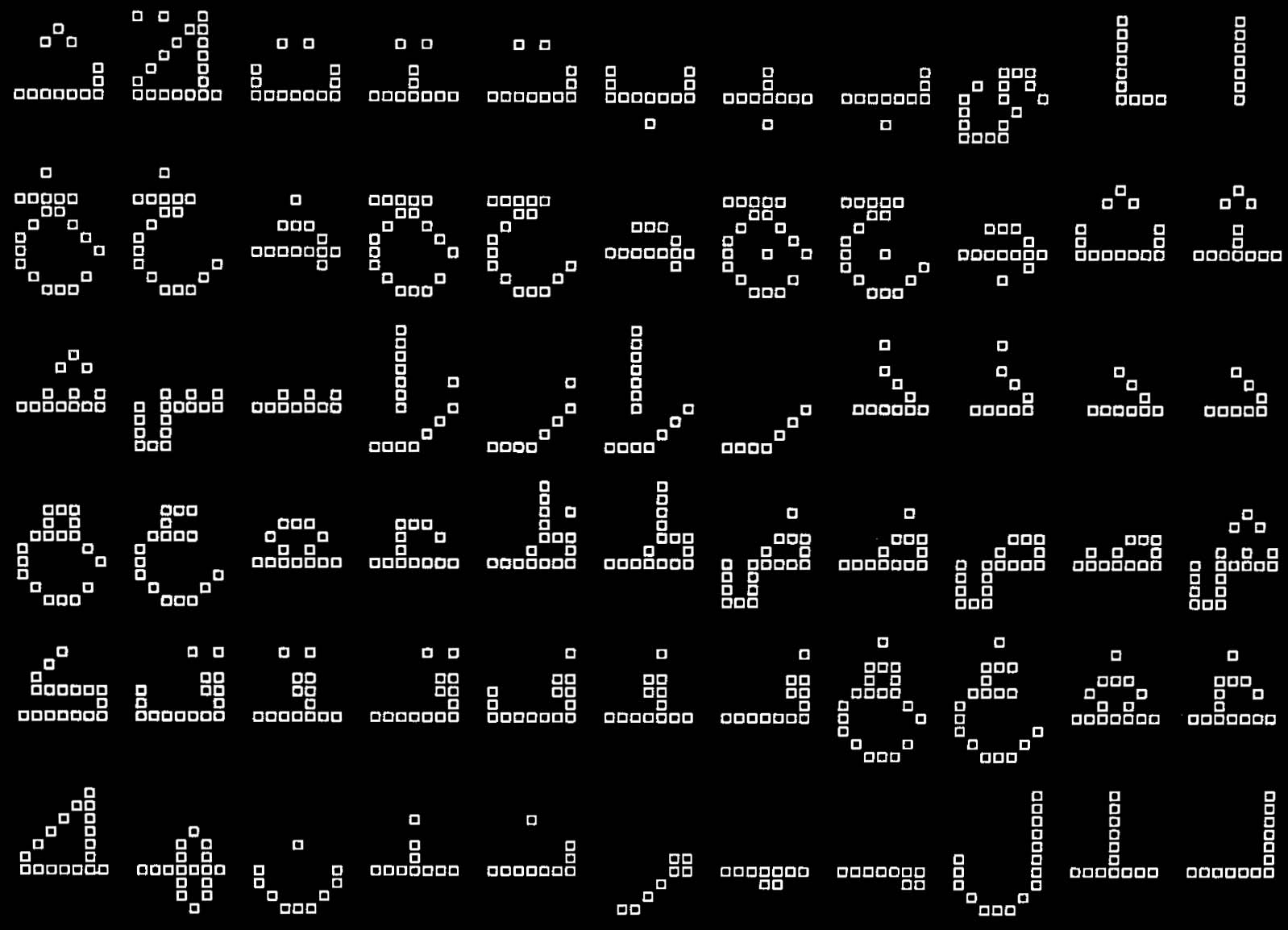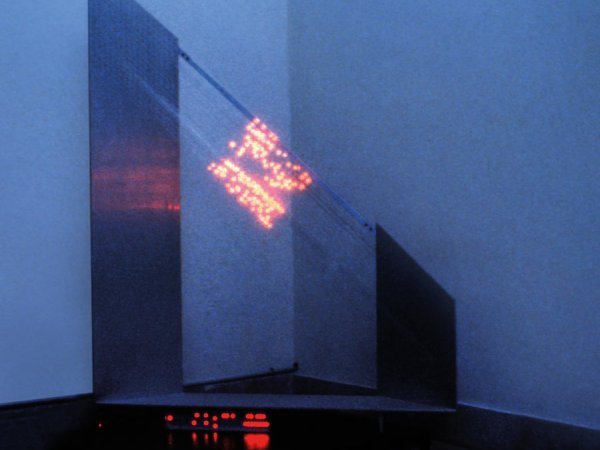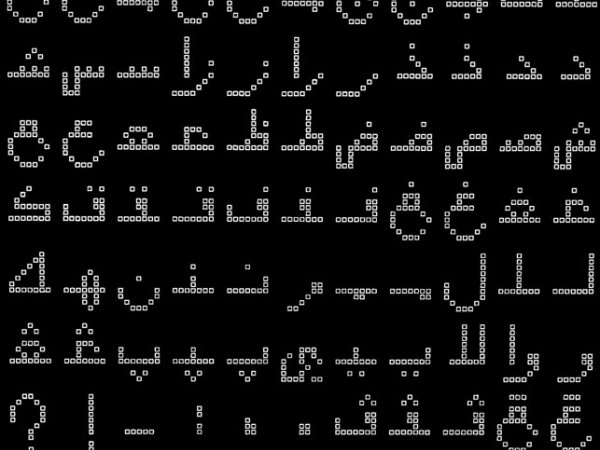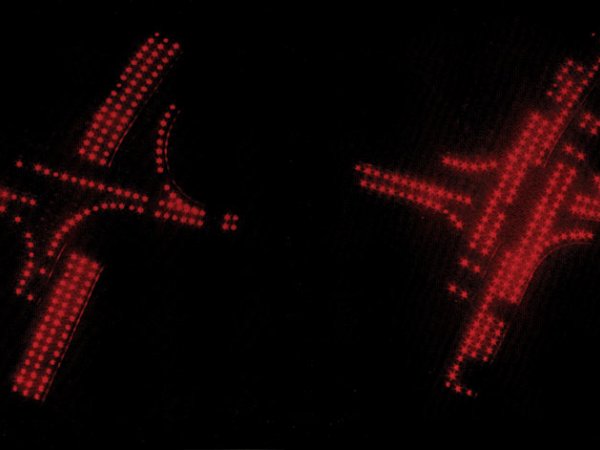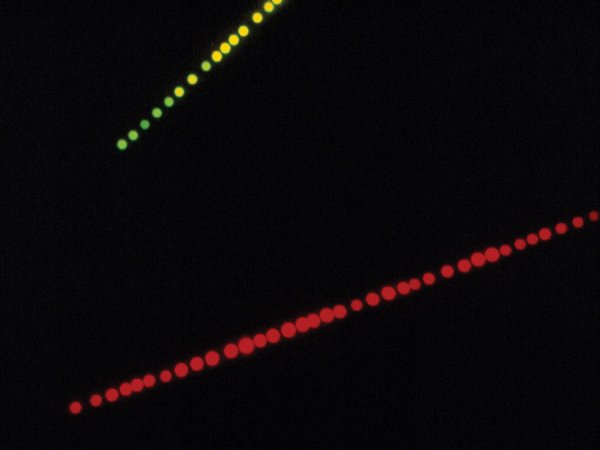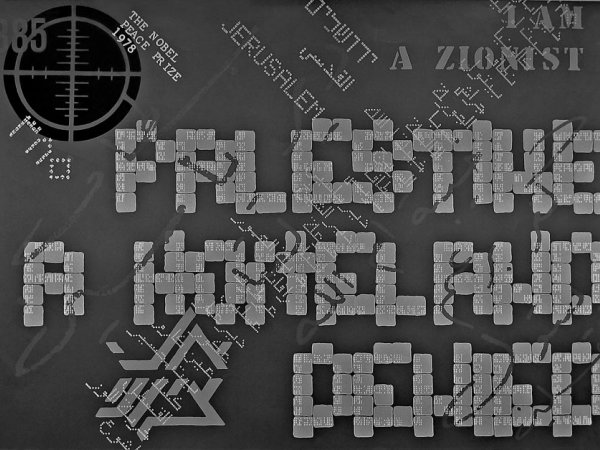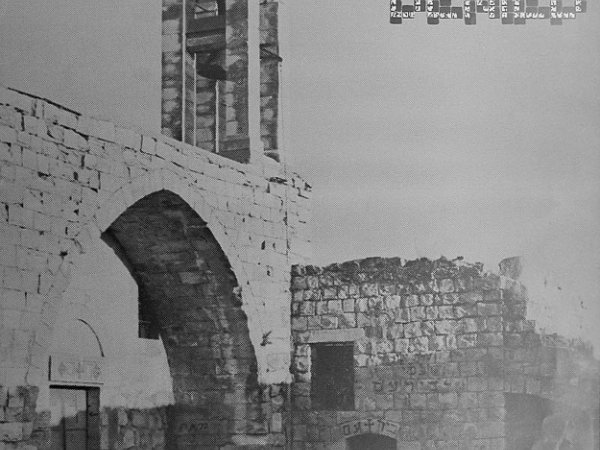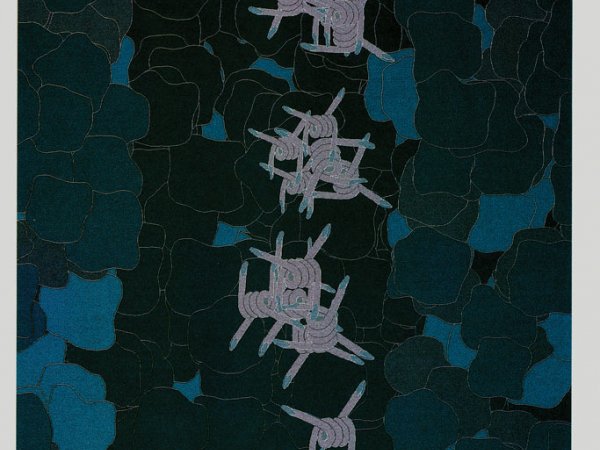Dynamic Object in Space, 1974-1975, interactive light sculpture
The first digitalization of Arabic script, 1973. In association with Anton Shamas
Traffic system controlled by microcomputers – urban infrastructure of the future, 1972-1975, model of an intersection in Jerusalem, 1975, 80 x 50 x 60 cm
Dynamic Line 64, 1975, electronic object, 66 x 66 x 5.5 cm
Palestine, a home dined, 1977-1979, poseter
Palestine, a home dined, 1977-1979, poster
Untitled, 1984, graphic, RECI & bcd [Digital] Graphical Data Base
Untitled, 1984, graphic, RECI & bcd [Digital] Graphical Data Base
In 1971 Vladimir Bonačić exhibited two luminous dynamic objects in Jerusalem at the exhibition Art and Science, one of the exhibitions marking the beginning of operations in the building of Tel Aviv Museum, and also took part in a symposium.1 In 1972 Bonačić moved from Zagreb to Jerusalem, where he founded and until 1977 ran the interdisciplinary programme Art and Science at the Bezalel Art and Design Academy in concert with the Museum of Israel.2 Since he kept in touch with the Ruđer Bošković Institute, for some time he retained the position of head of its Cybernetic Laboratory.
It was in Jerusalem in 1972 that the bcd – CyberneticArt team (below; bcd team) was set up; it operated in the areas of cyber-art, design and science. It comprised artist and cyberneticist Vladimir Bonačić (1938-1999), software designer Miroljub Cimerman (1945) and architect Dunja Donassy (1945). The bcd of the name of the group is taken from the initials of their surnames. On occasions, bcd team presented the work of the group under Bonačić's name, while some works were attributed to Bonačić and Donassy. All three took part in parallel in the work of the group and in teaching at the Jerusalem academy from 1972 to 1977, after which came life and work in Zagreb (1978-1980), and then life as freelancers, ultimately working out of Bonn, Germany. In the framework of the current project, their work will be tracked up to 1984.
During their work programme at Bezalel Academy, bcd team produced a number of art and design projects. In 1973 in Jerusalem they presented the project Traffic System Controlled by Micro-computers – the Urban Infrastructure of the Future, a design concept for a traffic system3 meant for use in urban public space and in public buildings.4 Abandoning the regular system of traffic lights, the authors proposed a new system of light signalling. In a later elaboration of the project, a model was produced that had lights. In the same year, 1973, bcd team in association with the Arab writer and poet Anton Shamas did the first successful digitalisation of Arabic script, which it subsequently used in its artworks.5
In Jerusalem they worked out various kinds of interaction in artworks from both practical and theoretical viewpoints, and spent some time on the use of brainwaves in artistic work.6 He upgraded and went on experimenting with the dynamic object GF. E (16,4) made in Zagreb in 1969 to 1971, which he showed at a big solo exhibition, Computer Art and Music in the Israel Museum in Jerusalem in 1975. Now, further communication with and control of the object was made possible with a keyboard and via an external monitor.
Works from the exhibition and Bonačić's artist statement were recorded in a short colour film, which works for us today as an excellent example of the documentation and archiving of time-based media art7 The film shows the artist controlling the dynamic imagery and sound of the object GF. E(16,4).8 In Jerusalem, Bonačić started using this object as an instrument for his music concerts. Technological advances enabled a different approach to the design and building of dynamic objects and expanded the possibilities of interaction with an object. Dynamic Object in Space (1974-1975) used the Single Board Computer (SBC, forerunner of the mother boards of the PCs of the 1980s) built into a microcomputer. Light sculpture, controlled by computer, spread out in the darkened gallery space via hardly visible filaments two metres long. On the filaments there were sequences of red LEDs, which at the same time lit up five Galois field rhythms.9 The following work, Dynamic Line 64 of 1975 used the Intel NCS-80 System Design Kit (SDK-80) for the generation of real-time Galois fields. The object made use of green and red LEDs, showing simultaneously three Galois field rhythms that in a pseudo-random sequence will be repeated only after 5 million years.
At the university in 1974, Bonačić organised an international seminar entitled Interaction of Art and Science10 in which several leading NT figures took part, like Jonathan Benthall, Herbert W. Franke, Frank Joseph Malina, Abraham A. Moles, A. Michael Noll and John Whitney. For its achievements in research development and use of heuristic programming of digital computers aiming at bridging the gap in the understanding of art and science, the programme Art and Science, at the recommendation of laureate Willem Sandberg,11 shared the Praemium Erasmianum in 1975. Not long after that, because of the radicalisation of Israeli society and the poor treatment of culture and education, in 1977 Bonačić organised and executed the collective resignation of the international committee of the programme Art and Science. They started openly engaging with social and political issues. Bcd team brought its stay in Jerusalem to a close and moved back to Zagreb.
Producing a socially aware and activist artistic work, bcd team12 did a series of art posters printed in serigraphy (1977-1979) in which there were some of the depictions of 385 Palestinian settlements that violently lost their centuries-old character and from which the Palestinians were expelled.13 As well as photographic reproductions, typographic elements were used, treated digitally, but this time the Galois field was
used as source of an original symbol of destruction that is never repeated, visually diverse and yet semantically an identical symbol. This symbol is used in the computer design of letters, particularly of Arabic and Hebrew, or in some posters during design that resulted in classic computer graphics, the semantic contents correlating with the set theme. The same elementary symbol was used in the design of the '385' symbol, which refers to the total number of Palestinian settlements destroyed, villages and cities, from 1948 until the present. Posters related to, for example Lartun or Eviction are authentic documents of the evictions of the civil population, Christian and Muslim, and documents about the planned disappearance of Arab villages and houses, particularly in Old Jerusalem.14
An exhibition of all 35 posters was organised in the Centre for Culture and Information in Zagreb by the coordinating committee of the RK SSRNH for help to liberation movements.15 The exhibition was called after the title of one of the works - Palestine, a Homeland Denied. As well as in art galleries, these posters were also shown in the context of graphic and poster design.16
While he was in Zagreb from 1978 to 1979 Vladimir Bonačić conceived and developed a multimedia library for the National and University Library (NUL). His project for the digitalisation of the library cards and the attributions of the materials of the NUL was suddenly halted under unexplained circumstances. In consequence, the three-member bcd team moved to Germany in 1980.
The art and design work of bcd team was characterised in 1980 by the use of PCs. They chose PCs produced by Compaq, which they enhanced in terms of performance according to the requirements of the project, designing their own, original, systems. Bcd team developed the technology of dynamic displays of graphs that presented in real time the results of political elections, used in live TV broadcasting. They applied it for the first time in reporting by the national TV station ARD about the German federal elections on October 5, 1980. Also employed were the telephone network for exchange of computer data and ready-prepared graphs rapidly manipulated by hand.
Dynamic TV graphs are standard today for the electronic media, but this one from 1980 was a first in world terms. They upgraded the system for further use at the German federal elections on March 6, 1983, and January 27, 1987. The project was produced in association with the computer centre of the Infas Institute (Institute for Applied Social Sciences), Bonn-Bad Godesberg. In 1983 computer data were transmitted via the telephone network directly into the studio via ICON, a graphic system for TV that used two PDP-11 mini-computers. By way of upgrade of this system, for direct online broadcast bcd team used TV Studios Distribution System, using PCs they developed themselves for the occasion. In the city elections in Saarbrücken on March 10, 1985, the image on the TV transmission was for the first-time broadcast straight from PC.
A 1984 series of art graphics by bcd team was exhibited in the organisation centre of RICI, Paris in the self-same year.17 Depictions of Galois fields used, not the flashing elements of the earlier works, but a new kind of visualisation, which showed irregular fields of colours grouped into differing planes and compositions. The following novelty was the introduction of figurative drawings of barbed wire, a motif to be repeated in later work.
The interactive art installation INSTANTANEOUS (1987) consisted of 16 PCs18 that controlled 16 monitors, depicting 64 Galois fields in real time. There were two extra PCs to drive the net, interaction of artist/viewer and installation, and interface with graphic database. The system was designed by bcd team. INSTANTANEOUS was presented at a solo exhibition of bcd team in Accademia Nazionale dei Lincei in Rome in 1987.19 In the same year in Paris Art Centre in Paris a solo exhibition of bcd team was put on, Visions for Cybernetic Art accompanied with an extensive catalogue presenting the graphics created by the INSTANTANEOUS system, along with those from 1984. In the biography section in the catalogue, bcd team published its philosophy, the concept of Dynamic Love, the central concept of which was inter-subjectivity:
Our love of others, 'Dynamic Love', makes inter-subjective communication possible in principle, when we consider or contemplate with wonder the autonomous status of subjective integrity in those we love. The bcd concept – 'Dynamic Love' - is challenging a well-defined phenomenon in Existentialist philosophy that inter-subjective communication is not possible. Such communication represents more than the factor that has assured the cohesion of the team for the past 16 years. It is the fundamental aim toward which every computer user should be striving, so that the technology which is available and developing today will help advance human freedoms and not subject people to new forms of alienation.20
-
The symposium was in the form of a roundtable meeting and took place after the lecture of Aharon Kalzir. Taking part in the discussion were, among others, Rene Berger, Frank Malina, Pierre Restany and Bruno Zevi. ↩
-
Vladimir Bonačić, "Man, Art, Science, An outline for the Jerusalem Program", Art and Science, 1973 (p. 16). ↩
-
Under this name and description, and under year it was produced stated that it was a process in progress, the work was shown at the 15^th^ Zagreb Salon, Situation 77/78, Proposal, 1980 (Applied Art and Design Salon) in the Art Pavilion in Zagreb and included in the catalogue. It was signed with the names of all the three artists. ↩
-
"Jerusalem-1973, Traffic Control", Design, Israel Museum, Introduction to Design, catalogue of an exhibition, Issadore and Sarah Pavletsky Design Pavilion, 1973, n. p. ↩
-
Impact of Science on Society, vol. 25, no. 1, January – March 1975, pp. 90–94.; UNESCO, Impact, vol. 27, no. 1, January – March 1977, annexe. ↩
-
Vladimir Bonačić, "Kinetic Art: Application of abstract algebra to objects with computer controlled flashing lights and sound combinations", Leonardo, vol. 7, Oxford/New York, Pergamon Press, 1974, p. 193. ↩
-
In work on the preparations for the exhibition, in bcd team archives in Germany in 2005, Darko Fritz discovered an unknown film reel. It was digitalized from the 16 mm sound strip and was shown in public for the first time at the exhibition Bit international [Nove] tendencije Computer und visuelle Forschung Zagreb 1961 – 1973 in Medienmuseum - Zentrum für Kunst und Medientechnologie (ZKM), 2008. – 2009, curated by Darko Fritz. After that the film was shown several times in galleries and, and a clip was used in the TV documentary film New Tendencies directed by Vladislav Knežević, editor Ana Marija Habjan, HRT, 2009. ↩
-
During work on the preparation of the exhibition, in the bcd team archives in Germany in 2005, Darko Fritz discovered an unknown reel of film. It was digitalised from the 16mm film and was for the first exhibited at the exhibition Bit international [Nove] tendencije Computer und visuelle Forschung Zagreb 1961 – 1973 at the Medienmuseum - Zentrum für Kunst und Medientechnologie (ZKM), 2008 – 2009, curated by Darko Fritz. After that the film was shown several times in galleries and, and a clip was used in the TV documentary film New Tendencies directed by Vladislav Knežević, editor Ana Marija Habjan, HRT, 2009. ↩
-
The work used a total of 256 red LEDs. ↩
-
The Bat-Sheva seminar on the Interaction of Art and Science, November 3-14, 1974, Jerusalem. ↩
-
PRAEMIUM ERASMIANUM MCMLXXV; Stichting Praemium Erasmianum, Amsterdam. ↩
-
In the catalogue of the Zagreb exhibition of 1979, the three authors were mentioned by name, and there is no mention of bcd team. In later exhibitions of the posters, the names of Bonačić and Donassy appear, or else all three names. ↩
-
Ivan Iveković, "Introduction", Palestine, a Homeland Denied, exhibition catalogue, Studio of Forum Gallery, Centre for culture and information, Zagreb, 1979, n. p. ↩
-
"Remarks", Palestine, a Homeland Denied, exhibition catalogue, Studio of Forum Gallery, Centre for culture and information, Zagreb, 1979, n. p ↩
-
RK SSRNH: Republican Conference of the Socialist Alliance of the Working People of Croatia. ↩
-
7^th^ International Poster Biennale Warsaw, 1978; Brno Biennale, 1978. ↩
-
LES ATELIERS, November 7 – December 14, 1984, Paris. ↩
-
Sixteen Compaq Deskpro 386 PCs linked in a LAN. ↩
-
On September 29, 1987, in concert with the exhibition, a colloquium was held, organised by UNESCO and the European Academy. ↩
-
"Biography", bcd,Visions for Cybernetic Art, Paris Art Centre, L\'academie Europeenne des sciences, des arts et des letters, Paris, 1987, n. p. ↩
